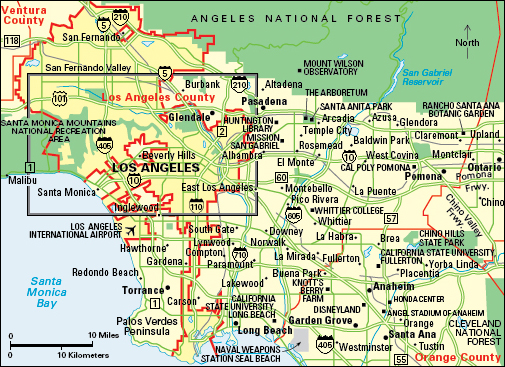Santa Ana (pop. 310,327) is one of the largest cities in southern California. It lies in the Santa Ana Valley, along the Santa Ana River, which often dries up during periods of little rainfall. The city is in the Los Angeles-Long Beach-Anaheim metropolitan statistical area. Santa Ana is a densely populated city with a large number of Hispanic American residents. It is the seat of Orange County and has a council-manager government.

Santa Ana has long been an important transportation hub. In 1878, it became the southern terminus (end) for the Southern Pacific Railroad. The Santa Fe Railroad came through the city in 1887. The Pacific Electric Railway connected Santa Ana with Los Angeles in 1905. Today, several major highways cross through the city. John Wayne Airport serves the area.
Santa Ana’s leading economic activities include health care and social services; engineering, legal, and other professional services; building maintenance services; and the manufacture of fabricated metal products and computer and electronic products. The Orange County Register, a daily newspaper, is published in the city.
American Indian groups—including the Gabrielino Indians, also known as the Tongva—occupied the Santa Ana area prior to the arrival of Europeans. In late July 1769, around the time of Saint Anne’s Day, an expedition led by the Spanish explorer Gaspar de Portolà passed through the Santa Ana Valley. The expedition named the area in the saint’s honor. Santa Ana later became part of Rancho Santiago de Santa Ana, a huge area that the Spanish granted to rancher José Antonio Yorba and his nephew Juan Pablo Peralta in 1810. Santa Ana was founded in 1869 and incorporated as a city in 1886.
See also Orange County .
